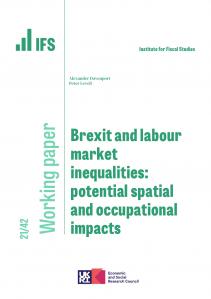The government plans to increase the share of business rates English councils retain from 50% to 75% in 2020, and is piloting 100% retention in parts of the country. This is a major change to local government funding. The aim is to increase the incentives councils have to grow these revenues and their local economies.
But a new report published by the IFS and funded by its Local Government Finance and Devolution Consortium shows that it also risks growing divergences between the funding available to different councils.
The report shows that significant divergences could arise in just a few years under 100% rates retention. This is because those councils which would have seen the biggest increases in their retained business rates revenues were often not the councils that experienced the biggest increases in their relative spending needs, for example, because their population became older, poorer or sicker. This implies that central and local government face a difficult trade off when moving to 75% or 100% rates retention. More frequent and fuller periodic redistributions of revenues could limit the scale of funding divergences. But they would also dampen the incentives for councils to grow revenues and tackle spending needs.
It is also not clear that the incentives provided by rates retention will translate into faster economic growth. The report finds no relationship between changes in the councils’ business rates tax bases and local economic growth, or indeed employment or earnings growth, in recent years. However, there is a link between changes in the value of business properties when they are re-valued (as in April 2017) and local economic growth. Most of the impact of these valuation changes is stripped out from the revenues actually retained by councils though, meaning little incentive for councils to boost local business property values.
The revenues and spending needs data also show that:
• Between 2006–07 and 2013–14, the assessed spending needs of different councils converged. In other words council areas became more alike in terms of how much money they were thought to need to provide similar levels of service. Deprivation became less concentrated in areas that were initially the poorest. At the same time the population aged more rapidly in those, generally richer, areas initially assessed to have lower needs. This latter trend is likely to have continued since then and to persist in the future.
• Changes in councils’ capacity to raise revenues from council tax and business rates varied significantly across England. After stripping out the overnight impact of the business rates revaluation on revenues – as happens under the business rates retention scheme – around one-in-ten council areas saw their tax raising capacity increase by 13% or less. Another one-in-ten saw it increase by 30% or more.
The report also shows how in shire areas where local government is split into two tiers – shire districts and counties – the way changes in business rates revenues are shared between these tiers can have a big impact on the scale of funding divergences:
• Shire district councils cover relatively small areas and their other revenues are relatively low. This means that divergences between their funding levels and assessed spending needs can grow very large when they bear a large part of the change in local business rates revenues. This is the case currently where they bear four-fifths of the 50% of revenue change retained locally.
• If this four-fifths allocation were maintained under a 100% retention scheme then divergences could grow very rapidly. Had such a scheme been in place between 2006-07 and 2013-14, then by the end of this period the quarter of districts doing worst would have had funding that was at least 13% lower relative to their spending needs than the quarter doing best.
• A natural response would be to increase the proportion of business rates changes borne by county councils which are bigger and could bear more change without so much divergence. This would also provide counties with stronger incentives to boost these revenues for example through education and skills, transport and strategic planning for which they are responsible. Districts, however, control most local planning decisions and their incentives would be weaker.
• If, as has historically been the case, business rates revenues grow in real-terms, allocating a higher share of this growth to counties would provide more resources for services counties have responsibility for, including social care and children’s services. However it would not, on its own, solve funding issues for these areas of spending.
“The lack of relationship between changes in business rates and economic and employment growth is important. Areas seeing lots of new developments aren’t guaranteed strong economic growth. And growth doesn’t necessarily rely on large-scale property development“, said David Phillips, Associate Director at the IFS. “This does not mean the incentives for councils to encourage property development that are provided by business rates retention aren’t useful. But it does suggest that if the government wants to encourage councils to take a more active role in promoting growth, other incentives could play a useful role as well. This could include allowing councils to retain part of other taxes such as income tax.”
“The high share of changes in local rates revenues currently borne by shire district councils in two-tier areas can lead to big divergences in the funding of these districts. And it means that counties with their low shares lose out on real-terms growth in rates revenues”, said Neil Amin-Smith, Research Economist at the IFS. “As we move to 75% and possibly 100% business rates retention, it is worth considering whether counties should bear a larger share of the changes in revenues. Doing this could help limit the scale of funding divergences among districts and stop counties – who fund social care services – from getting ‘left behind’. But it would also shift more of the incentive to boost business rates revenues and some more financial risk on to counties as well: a risk that could come back to bite if business rates revenues fall rather than grow in real terms in future.”
Ends
Notes to editors
1. The report ‘Spending needs, tax revenue capacity and the business rates retention scheme’ will be available on the IFS website from Thursday 1st March. Embargoed copies are available for the press prior to that. Please contact the IFS Press office on 020 7291 4800 / 07730 667013 if you want a copy or have any queries.
2. This research forms part of a major programme of work funded by The Local Government Finance and Devolution Consortium. This consortium is generously supported by Capita, CIPFA, ESRC and PwC and is also supported by the Municipal Journal and a large group of local government bodies, including the Society of County Treasurers and a number of unitary, district, metropolitan, and London councils.









